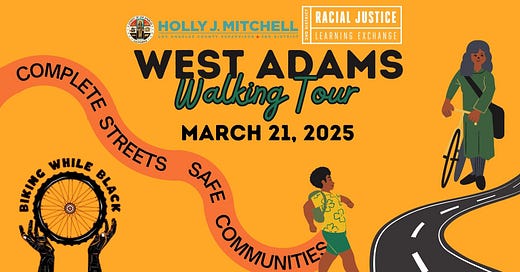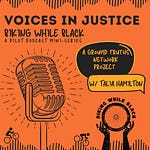In March, the office of LA County Supervisor Holly Mitchell (SD2) worked with Biking While Black to organize a walking tour of West Adams. Through this tour, participants learned about how they can start thinking about their community through a perspective of mobility justice.
Speakers like Dr. Adonia Lugo of the California Transportation Commission, Lauren Ballard of Mobility Planning at Los Angeles Department of Transportation, Alex Ramirez of LA Walks, and Eli Lipman of Move LA brought attendees through an experiential walking tour to learn about what to look for and what questions to ask when you’re walking around your community.
We’re bringing you this recap video just in time for Juneteenth and beyond to give you the inspiration to see all communities through the lens of mobility justice.
Lauren Ballard from the LADOT introduced the attendees to the city’s high-injury network is being targeted for improvements in order to reach Vision Zero goal of eliminating traffic deaths. “The high-injury network is a small percentage of the city streets that see the overwhelming majority of traffic crashes that injure people,” Lauren told the walking tour participants. “You are standing on one of those streets—Adams Boulevard between Fairfax and Crenshaw.”
Our executive director, Yolanda Davis-Overstreet, pointed out in this context that the work the city in partnership with Yolanda’s community-based advocacy and other local organizations is a mobility justice model for all to see how residents and community stakeholders can make, request, and even demand justice and joy changes in their communities.
Beginning with that background was important to point out the context that Dr. Adonia Lugo helped participants reflect on more deeply. She urged the attendees to ask questions as they walk the streets. She emphasized the anthropological research methods: “You’re there, in your body and you're looking around, you're using your senses, you're noticing what's happening.”
Some questions she suggested the participants reflect upon included:
Do you see plants and animals?
What kind of evidence of economic investment?
Do you see evidence of community ownership, creativity?
How do you see people interacting? Is it positive, negative?
You can also take these questions when you’re walking around your community. When you make your observations and answer those questions, take that farther and ask yourself — why might there might or might not be plants and animals? What does that mean for the community? Why might there not be any there? Does economic investment or lack thereof mean? What might have been the reasons it is or is not invested in? What might the evidence of community ownership mean?
A lot of what you’ll observe, as all of the speakers highlight, are due to historic decisions that were made. Redlining and later, urban renewal, led to disinvestment in Black and Brown communities that today we see in streets with very little economic investment and more dangerous traffic. But it’s important that we all walk the streets to observe for ourselves what it all means.
Another lens through which we should look at our communities is through physical mobility. As Alex Ramirez from LA Walks asks the tour participants, “what would it be like if you didn’t have a car? What if you moved around in a wheelchair? What would that be like?”
And finally, Move LA’s Eli Lipman talked with participants to observe what was happening and one intersection in particular—West Haven and LaBrea. “It is the only light between West Haven and La Brea,” he says—that distance is over a half-mile between the two major streets. “This is a safety issue because there’s a lot of fast-moving cars, so the residents trying to get to the library here or to the rec center, that’s the only place to cross. And the cross-walk is not very long, it’s only 24 seconds and if you’ve got kids or you’re not that quick of a mover, you can barely make it across the intersection.”
We would love for you to take the lessons learned in this video and ask the questions above when you walk your neighborhoods. Tell us in the comments what you have observed in your community or what you might want to do differently.
The road to mobility justice requires constant questioning and learning and we’re excited that we can help bring that to our community.
By doing this, you’re doing what Yolanda urges the attendees: Be the change that you want to see!









Share this post